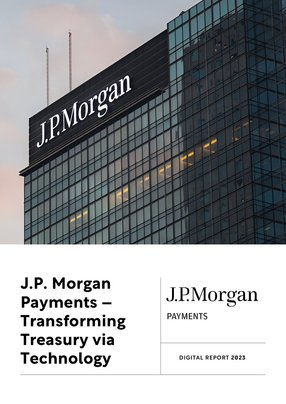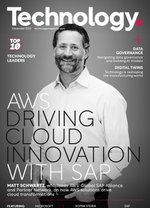J.P. Morgan Payments – Transforming Treasury via Technology
As a leader in payments with nearly 150 years of experience, J.P. Morgan Payments has a deep understanding of the impact of technology on Treasurers and their partners.
This technology, when implemented correctly, can enhance a Treasurer’s ability to perform their core responsibilities, and their value to the organisation.
Michael Brady, Executive Director, Liquidity and Account Solutions at J.P. Morgan Payments, says better technology and data leads to more informed decision making, resulting in better forecasting and improved control.
“At their core, a Treasurer is responsible for ensuring the company has the right amount of money, in the right entity, in the right currency, in the right location and at the right time to ensure financial obligations are met,” says Brady.
“Having the right technology infrastructure can unlock the data and insights necessary to more accurately view current cash positions and forecast future cash needs. This ultimately leads to freeing up working capital, improved FX hedging, and overall improvements in capital efficiencies. Additionally, technology can reduce operational risks associated with manual processes and, ultimately, free up resources.”
The key phrase there is “the right technology”. With so many solutions on the market, Treasurers can easily find themselves swamped with disjointed systems that lead to unnecessary complication and inefficiencies.
Brady backs this up, saying that the issue J.P. Morgan Payments hears of most often is fragmented platforms that lead to lack of both centralisation and visibility into cash positions globally.
“This lack of controls results in excess cash buffers, which has become increasingly punitive in an elevated rate environment,” explains Brady.
“Along with lack of control/visibility, we also see an increased focus on the move towards real-time data to help further reduce idle cash. The main reason for these challenges is twofold. First, lack of understanding the art of the possible and keeping up with new trends in treasury technology, and second, lack of availability of resources on the treasury and technology side of companies.”
Application programming interfaces, or APIs, allow applications to speak to one another and can therefore support digital transformations such as real-time payments and real-time visibility into cash positioning. These innovations can be good news for both partners and Treasurers, but they do require Treasurers to have a foundational understanding of APIs – as well as which ones are most useful when it comes to meeting business goals. Treasurers need to be able to communicate confidently about APIs with technology leaders within the organisation.
“The world of Treasury has shifted and is rapidly moving towards real-time to reduce capital buffers and create operational efficiencies. APIs are a tool that is driving this evolution,” says Brady.
“In a rapidly changing economic environment with elevated rates, the benefit of having real-time insights into cash positions is invaluable, and the flexibility the APIs provide will be transformative.
“APIs are really the present and the future. Where we see the biggest challenge is with the understanding of APIs and how powerful they can be in a company’s treasury transformation journey.”
APIs are on a rapidly evolving journey with the ability to monitor and initiate payments in real-time to transform Treasury. All of this of course comes with a cost, particularly when working in a legacy technology environment. The technology investment and resources need to be carefully taken into consideration, but the adoption of APIs is becoming more and more streamlined and may be easier and more powerful than some Treasurers realise.
Of course, Treasurers are rightly concerned with cost when it comes to capital expenditure on new technology, and while virtual solutions are not new, there has been an increased focus and investment in them thanks to the cost benefits they can bring. Brady, however, believes there is a bigger picture to consider.
“When it comes to virtual solutions, the number-one driver from clients is cost reduction as a result of account rationalisation,” he says. “Can there be a cost benefit? Sure, but we encourage clients to think more broadly. What is the art of the possible? If you could have the most granular level of reporting, insights, and visibility, what would that look like? What resources would that free up? How much working capital could you free up with better reporting? What operational efforts or risks could be reduced or eliminated?”
Brady says virtual solutions can create subledgering of funds within a single physical account, creating the ability to slice and dice transactions within that account to create the ultimate in flexibility in reporting.
Historically, companies had to open hundreds or thousands of accounts to get this level of visibility. The improved visibility not only creates natural business insight benefits, but also limits idle cash as concentration is native within virtual structures. Lastly, virtual structures can significantly reduce the burden of cash application and manual reporting processes.
“The key with virtual solutions is creating a flexible structure and having a partner that is continuing to invest in their platform as technology and adoption of virtual solutions evolve,” says Brady. “Here at J.P. Morgan Payments, we have built our virtual solutions platform in-house, which makes it more flexible, and we are continuing to invest in it to suit our clients’ needs.”
Treasury transformation is not a one-size-fits-all, one and done approach. It is important to not just think of what you need to solve now, but rather to consider what is the art of the possible, and work backwards from that.
There will inevitably be low-hanging fruit, and there will also be heavy lifts. When thinking of the heavy lifts, keep in mind the return in terms of unlocking capital, freeing up resources or gaining more insights to drive business.
View it as a journey, which, as technology advances, will be ever evolving. That is why flexibility is so important
When it comes to the best strategy for creating a digital ecosystem to enable and accelerate digital transformation, again, there is no single ‘silver bullet’ solution.
“Does it make sense to invest in the most robust treasury management system? Maybe. Maybe not. What features are you realistically going to use and is it worth the investment?” asks Brady.
When it comes to the potential benefits, there are a few key aspects to consider.
First, what manual processes can you replace? This should be assessed both from an operational risk perspective and also a resourcing perspective.
Second, how much working capital can you unlock, and what is the most efficient way to deploy it? With rates elevated, the benefits can be significant, but it is also important to perform sensitivity analysis around yields to ensure ROI projections are accurate should current economic conditions change drastically.
Lastly, and less tangible, is the importance of flexibility of your tech ecosystem.
The secret of a successful digital transformation lies in fluency between Treasurers and Chief Technology Officers (CTOs). Only when these vital functions are aligned will the organisation truly evolve.
“With many companies evolving into new lines of business or expanding into new markets with globalisation, we are seeing increased alignment between Treasury and the Business lines as a result of the cash implications of these evolutions,” says Brady.
“As the demand on Treasury increases, Technology must also have a seat at the table to understand the implications the Treasury infrastructure has on the overall working capital of the company. Treasury should view Technology as a critical partner and involve them in project decisions so that Technology not only understands the language of treasury, but vice versa as well.
“With resources limited on both sides, it is important have a have a clear sense of the implication of projects and decisions on one another.”
There are pressures on both sides to deliver transformation via technology in a cost-effective manner, which is why due diligence is essential to enable smooth project delivery and ROI.
This is where the Treasurer and CTO can work in tandem to secure the best business outcomes.






